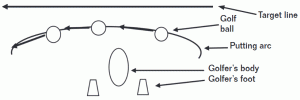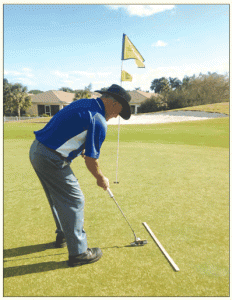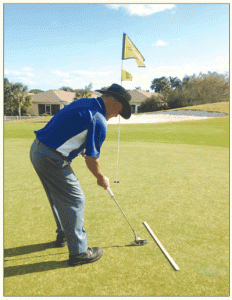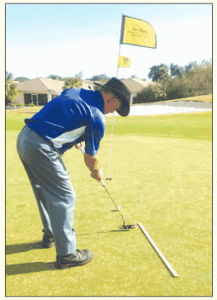By Dr. Gerald A. Walford USGTF Certified Golf Teaching Professional® The Villages, Florida

 This is the stance. An open stance is used to aid in the putter moving straight back. The front elbow is locked to the body instead of the putter locking to the body. Individual preference will determine the amount of open stance needed. The yard-stick shows the target line.
This is the stance. An open stance is used to aid in the putter moving straight back. The front elbow is locked to the body instead of the putter locking to the body. Individual preference will determine the amount of open stance needed. The yard-stick shows the target line.


Take a golf ball and pick a target, either on a golf green or your carpet at home. Crouch or bend over as you would in rolling a bowling ball. Roll the ball to the target. Chances are you rolled the ball accurately. You have just executed the way you should putt.
You stood facing the target, looked at the target and rolled the ball with your dominant arm. You did not use two hands, because if you used two hands it would be difficult to roll the ball accurately. The roll is a one-arm swing. You did not tell yourself how hard to roll the ball. You looked at the target and your eyes told your muscles how hard to roll the ball.
Very often when putting, we putt with two hands facing 90° away from the target. We look at the target, tell ourselves how hard to hit the ball, then look at the ball and then stroke the ball. Very often, if the first putt was long, our next putt was short. When the first putt goes long, we tell ourselves to hit the next putt easier, and as a result, we end up short. This dilemma occurs when our mind is telling us how hard to hit the putt and the eyes are telling us how hard to hit the putt. This results in confusion between the eyesight and the mind.
We practice trying to take the putting stroke straight back and straight through. With the conventional stance, we are fighting biomechanics and the laws of physics. When we stand erect, our arms swing around the body in an arc and so does the putter head. Ball placement in this arc must be accurate or the ball will go to the right or to the left of the target.

We buy putting aids, we use many tricks like different hand positions, different hands low, different stances, and nothing works. With lots of practice, some of these idiosyncrasies may work, but very often, not for long.
Putting is a one-armed stroke. We did not roll the ball to the target with two hands. The following is a putting method, called revolutionary by some, and loved by many because of the success they have achieved stroking the ball to the target with excellent distance control.
Select your putter. The length of the putter does not matter. Just remember, with the long putter, do not anchor the end of the putter to your body. Instead, you will anchor your elbow nearest the target to the side of your body. This stabilizes the top hand for the putting stroke. The length of the putter will determine the amount your body will bend over.
The top hand or arm anchors to the body with the elbow no matter the length of the putter. This arm is your stabilizer. It stabilizes the putter for the stroke. The lower hand assumes a split grip that can vary in length, but give it a good split because this is your putting stroke just like you rolled the ball to the target with your hand.
 This is the stance. An open stance is used to aid in the putter moving straight back. The front elbow is locked to the body instead of the putter locking to the body. Individual preference will determine the amount of open stance needed. The yard-stick shows the target line.
This is the stance. An open stance is used to aid in the putter moving straight back. The front elbow is locked to the body instead of the putter locking to the body. Individual preference will determine the amount of open stance needed. The yard-stick shows the target line.
The body is in an open position, very much open, at least 45°. As you will notice in the photos, simply pull the back arm and elbow back and then push the forearm forward through the ball to the target. You will notice the putter head go straight back and straight through naturally to the target. This is the key. The open stance gives the pull-back by the elbow a straight line to the stroke and target. This is natural and within the laws of physics; no adjustments to the swing are made. The putt must go straight.
Try this. With a ball in hand, roll it to a target and notice how far your hand swings back and through. Do this several times until you get a good feel as to how far the ball rolls with how far your hand swings back. Do the same thing with different targets and different lengths. Now take your putter and putt the ball to these targets. You will notice and feel how the hand swung back the same distance with the putter as when you rolled the ball to the same target.
I taught this to a club pro, and his routine for every putt would be to swing his arm with an imaginary ball to the target. He then got the feel for the putt’s distance. He would then stroke the ball to the same arm swing. He qualified for the U.S. Open.
As an aid to distance control, some have found that for every inch of backswing the ball will roll 1 foot or 2 feet depending on the individual. Some will take their putter and use the length of the putter blade to determine their backswing length. If the putter is 4 inches long, a golfer can measure 4, 8, 12 inches, etc., for his backswing length. The golfer can then place the back foot at this length and swing the putter back to the toe and then through the ball.
As you go to putt, look at the hole and feel the distance. Then look at the ball and stroke the ball quickly. Wait too long and the feel will be lost. Do not tell yourself how hard to stroke the ball. The eyes know and have told the body. As you stroke the ball, keep the image of the target’s distance in your mind and let the feel just hap-pen as you did when you rolled the ball from your hand.
The elbow pulls back. The body is stationary. Notice how the putter blade has moved straight back. No arc.

Notice how the putter blade has moved through the ball in a straight line as the back forearm is pushed to the target. No body movement except for the back shoulder which will have moved slightly to the target after the ball has been struck. The front arm is a stable rod and the back arm is a piston pushing the ball to the target.

Copyright © 2023 United States Golf Teachers Federation, All Rights Reserved
200 S. Indian River Drive, Suite #206, Fort Pierce, FL 34950
772-88-USGTF or 772-595-6490 - www.usgtf.com
200 S. Indian River Drive, Suite #206, Fort Pierce, FL 34950
772-88-USGTF or 772-595-6490 - www.usgtf.com
